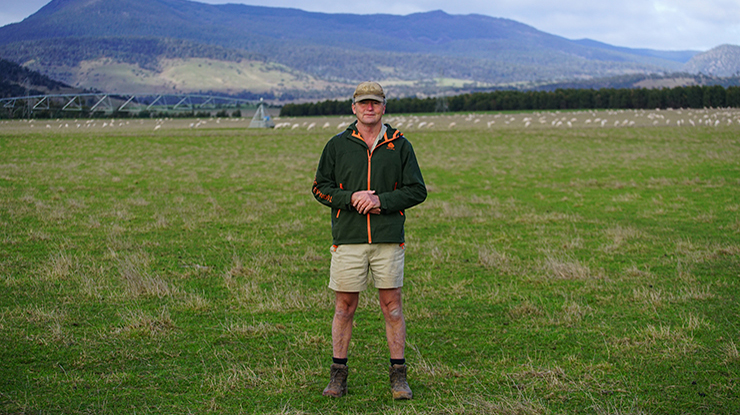Simplifying business for a sustainable future
01 November 2022

Tasmanian producer Roderic O’Connor has lifted profits and protected the landscape for generations to come by streamlining operations and taking a long-term approach to sustainability.
‘Connorville’ in Tasmania’s northern midlands is one of the state’s original pastoral stations and has been in Roderic’s family since it was established in 1824.
This legacy hasn’t held the family back and the O’Connors have moved with the times to keep profit margins on the rise.
“We used to produce Saxon superfine wool, but when the fine wool market dropped we weren’t making a great return – so I thought, there’s got to be another way to do it,” Roderic said.
“We had two wool and sheepmeat operations, a cattle operation, a deer farm, one cattle stud and two Merino studs – and it just got too much.
“We decided to have a whole farm change – now we’ve only got one fine wool operation, one prime lamb operation and a commercial cattle operation.
“We worked out what our country could best do for conservation, for our future stocking levels and set everything according to that – and within a couple of years, we were pretty much grossing what we had previously grossed with this new approach.”
Conserving land, building profit
Sustainability is a priority for the business and Roderic has dedicated a vast swathe of the 17,800ha property to conservation projects which aim to protect the landscape for long-term benefit.
“We now have about 23% of the property in a perpetual conservation covenant,” Roderic said.
“You can graze stock on there, but it’s limited, and it’s intended to stay that way forever.
“Some people think you’re binding your successors’ hands by doing that, but it actually shows them the true value of this ground and that we need to look after it.”
In fact, Roderic strongly believes improving the sustainability of his livestock enterprise goes hand-in-hand with improving profitability and efficiency.
This is evidenced with an ongoing venture into carbon farming on Connorville.
“About seven years ago, we started a carbon farming project along with a group of other producers – it’s the only one of its kind in Australia,” Roderic said.
“We’ve got a 25-year agreement with the Emissions Reduction Fund where we’re sequestering carbon by choosing not to harvest our commercial native forests, generating Australian Carbon Credit Units that we can trade.”
Efficient infrastructure
The O’Connors strive for maximum efficiency on-farm and have reinvested in infrastructure on Connorville to reduce labour costs and time.
“We’ve reduced the need to have additional staff all the time by rebuilding a lot of our infrastructure, including the shearing shed, cattle yards and sheep yards,” Roderic said.
“Everything’s really been designed to be operated single-handedly if needed, just to get it to really flow well for the stock."
Seasonal resilience
In response to his region’s climatic variability, Roderic’s emphasis on livestock and feedbase management has been key to driving Connorville’s profitability.
“Springs and autumns have been erratic in the past decade,” he said.
“We’re finding we’re doing things now that we never would have done 15 or 20 years ago, for example fattening or holding more stock through.
“As we have cold winters, we can get seasonal dry periods which can be quite severe – so we have to be very quick to respond with management.”
Strategic breeding, stocking rates, pivot irrigation systems and feed budgeting are just some of the main ways the O’Connors have stayed productive and profitable despite seasonal extremes.
“We set stock our cattle but probably at 40% of the region’s average stocking rate, and we do a form of rotational grazing for sheep,” Roderic said.
“Stocking rates are low per paddock (ranging from 0.5 DSE/ha in conservation areas through to 50 DSE/ha elsewhere) and we aim to retain around 2,500kg of dry matter per hectare as a minimum through any season.
“A breeding strategy that enables quick recovery without reducing too much of the breeding herd is also helpful if it’s dry.
For example, I sold cattle in a drought, but I knew we had a lot of young ones coming the next year, so it only took us a year to recover.
“We also have a fairly large pivot irrigation project that we can use to dial up feed in a drought.”
The irrigation covers 900ha using centre pivots and a limited closed‑loop gravity system, and they’ve recently added another 700ML dam – but only use around 15% of their total water licence capacity.
“Managing our feed budget regularly is a basic way we stay resilient – I did a course on using MLA’s feed budgeting tool about five years ago and I’ve found this tool really useful for mapping out our feed budget for two to three months ahead.”
Targeted land management
Roderic maximises productivity across Connorville’s highly variable landscape, soils and pastures by managing different areas of the property according to the land class.
“Adjusting our fertiliser rates depending on land condition has helped us maximise the productivity of our available feedbase to the benefit of our livestock,” he said.
Taking the leap
When it comes to building productivity and sustainability on-farm, Roderic said doing the research into what does and doesn’t work was essential to achieving business goals.
“If something’s not working or making you money, you’ve got to work out what that is and change that – but if you’re going to change your operation, you really need to do your homework,” Roderic said.
“On Connorville, we’re going back to simplicity and what our country can best do – and that works for us.”


